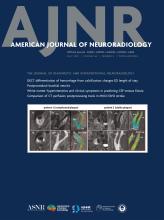This article requires a subscription to view the full text. If you have a subscription you may use the login form below to view the article. Access to this article can also be purchased.
Abstract
BACKGROUND AND PURPOSE: The amount and distribution of cerebral microbleeds (CMB) are important risk factors for cognitive impairment. Our objective was to train and validate a deep learning (DL)-based segmentation model for cerebral microbleeds (CMBs) on SWI and to find associations among CMB, cognitive impairment, and vascular risk factors.
MATERIALS AND METHODS: Participants in this single-institution retrospective study underwent brain MRI to evaluate cognitive impairment between January and September 2023. For training the DL model, the nnU-Net framework was used without modifications. The performance of the DL model was evaluated on independent internal and external validation data sets. Linear regression analysis was used to find associations among log-transformed CMB numbers, cognitive function (Mini-Mental Status Examination [MMSE]), white matter hyperintensity (WMH) burden, and clinical vascular risk factors (age, sex, hypertension, diabetes, lipid profiles, and body mass index).
RESULTS: Training of the DL model (n = 287) resulted in a robust segmentation performance with an average Dice score of 0.73 (95% CI, 0.67–0.79) in an internal validation set (n = 67) and modest performance in an external validation set (Dice score = 0.46; 95% CI, 0.33–0.59; n = 68). In a temporally independent clinical data set (n = 448), older age, hypertension, and WMH burden were significantly associated with CMB numbers in all distributions (total, lobar, deep, and cerebellar; all P < . 01). The MMSE was significantly associated with hyperlipidemia (β = 1.88; 95% CI, 0.96–2.81; P < . 001), WMH burden (β = −0.17 per 1% WMH burden, 95% CI, −0.27–0.08; P < . 001), and total CMB number (β = −0.01 per 1 CMB, 95% CI, −0.02–0.001; P = .04) after adjusting for age and sex.
CONCLUSIONS: The DL model showed a robust segmentation performance for CMB. In all distributions, CMB had significant positive associations with WMH burden. Increased WMH burden and CMB numbers were associated with decreased cognitive function.
ABBREVIATIONS:
- CMB
- cerebral microbleed
- DL
- deep learning
- DSC
- Dice similarity coefficient
- HDL
- high-density lipoprotein
- LDL
- low-density lipoprotein
- MMSE
- Mini-Mental Status Examination
- nnU-Net
- no-new-Net
- SVD
- small-vessel disease
- WMH
- white matter hyperintensity
- © 2025 by American Journal of Neuroradiology












